This article covers the history and bibliography of Romania and links to specialized articles.
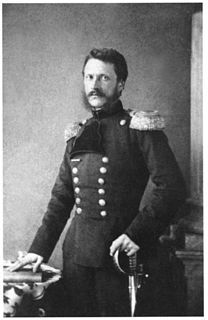
Alexandru Ioan Cuza was the first domnitor (Ruler) of the Romanian Principalities through his double election as prince of Moldavia on 5 January 1859 and prince of Wallachia on 24 January 1859, which resulted in the unification of both states. He was a prominent figure of the Revolution of 1848 in Moldavia. Following his double election, he initiated a series of reforms that contributed to the modernization of Romanian society and of state structures.

Moldavia is a historical region and former principality in Central and Eastern Europe, corresponding to the territory between the Eastern Carpathians and the Dniester River. An initially independent and later autonomous state, it existed from the 14th century to 1859, when it united with Wallachia as the basis of the modern Romanian state; at various times, Moldavia included the regions of Bessarabia, all of Bukovina and Hertsa. The region of Pokuttya was also part of it for a period of time.

Wallachia or Walachia is a historical and geographical region of Romania. It is situated north of the Lower Danube and south of the Southern Carpathians. Wallachia is traditionally divided into two sections, Muntenia and Oltenia. Wallachia as a whole is sometimes referred to as Muntenia through identification with the larger of the two traditional sections.
The Romanian Old Kingdom is a colloquial term referring to the territory covered by the first independent Romanian nation state, which was composed of the Romanian Principalities: Wallachia and Moldavia. The union of the two principalities was achieved when, under the auspices of the Treaty of Paris (1856), the ad hoc Divans of both countries, which were then under Ottoman Empire suzerainty, voted for Alexander Ioan Cuza as their prince. This process achieved a de facto unification under the name of the United Principalities of Moldavia and Wallachia. The region itself is defined by the result of that political act, followed by the Romanian War of Independence, the inclusion of Northern Dobruja and the transfer of the southern part of Bessarabia to the Russian Empire in 1878, the proclamation of the Kingdom of Romania in 1881, and the annexation of Southern Dobruja in 1913.
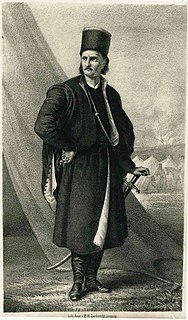
Tudor Vladimirescu was a Romanian revolutionary hero, the leader of the Wallachian uprising of 1821 and of the Pandur militia. He is also known as Tudor din Vladimiri or, occasionally, as Domnul Tudor.

Alexandru G. Golescu was a Romanian politician who served as a Prime Minister of Romania in 1870.

Danubian Principalities was a conventional name given to the Principalities of Moldavia and Wallachia, which emerged in the early 14th century. The term was coined in the Habsburg monarchy after the Treaty of Küçük Kaynarca (1774) in order to designate an area on the lower Danube with a common geopolitical situation. The term was largely used then by foreign political circles and public opinion until the union of the two principalities in 1859. Alongside Transylvania, the United Principalities of Moldavia and Wallachia became the basis for the Kingdom of Romania, and by extension the modern nation-state of Romania.

Michael the Brave, born as Mihai Pătrașcu, was the Prince of Wallachia, Prince of Moldavia (1600) and de facto ruler of Transylvania. He is considered one of Romania's greatest national heroes. Since the 19th century, Michael the Brave has been regarded by Romanian nationalists as a symbol of Romanian unity, as his reign marked the first time all principalities inhabited by Romanians were under the same ruler.

General Gheorghe Magheru was a Romanian revolutionary and soldier from Wallachia, and political ally of Nicolae Bălcescu.
The Early Modern Times in Romania started after the death of Michael the Brave, who ruled in a personal union, Wallachia, Transylvania, and Moldavia – three principalities in the lands that now form Romania – for three months, in 1600. The three principalities were subjected to the Ottoman Empire, and paid a yearly tribute to the Ottoman Sultans, but they preserved their internal autonomy. In contrast, Dobruja and the Banat were fully incorporated into the Ottoman Empire.

Regulamentul Organic was a quasi-constitutional organic law enforced in 1831–1832 by the Imperial Russian authorities in Moldavia and Wallachia. The document partially confirmed the traditional government and set up a common Russian protectorate which lasted until 1854. The Regulamentul itself remained in force until 1858. Conservative in its scope, it also engendered a period of unprecedented reforms which provided a setting for the Westernization of the local society. The Regulamentul offered the two Principalities their first common system of government.

Simion Movilă, a boyar of the Movileşti family, was twice Prince of Wallachia and Prince of Moldavia from July 1606 until his death.
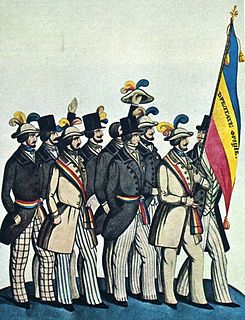
The Wallachian Revolution of 1848 was a Romanian liberal and nationalist uprising in the Principality of Wallachia. Part of the Revolutions of 1848, and closely connected with the unsuccessful revolt in the Principality of Moldavia, it sought to overturn the administration imposed by Imperial Russian authorities under the Regulamentul Organic regime, and, through many of its leaders, demanded the abolition of boyar privilege. Led by a group of young intellectuals and officers in the Wallachian Militia, the movement succeeded in toppling the ruling Prince Gheorghe Bibescu, whom it replaced with a Provisional Government and a Regency, and in passing a series of major progressive reforms, first announced in the Proclamation of Islaz.

The military history of Romania deals with conflicts spreading over a period of about 2500 years across the territory of modern Romania, the Balkan Peninsula and Eastern Europe and the role of the Romanian military in conflicts and peacekeeping worldwide.

Romania–Russia relations are the foreign relations between Romania and Russia. Romania has an embassy in Moscow and consulates-general in Rostov-on-Don and Saint Petersburg. Russia has an embassy in Bucharest and a consulate-general in Constanţa. Historical relations have oscillated among grudging cooperation, neutrality, open hatred and hostility.
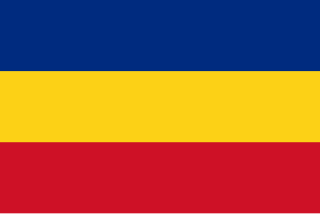
The United Principalities of Moldavia and Wallachia, commonly called United Principalities, was the personal union of the Principality of Moldavia and the Principality of Wallachia, formed on 5 February [O.S. 24 January] 1859 when Alexandru Ioan Cuza was elected as the Domnitor of both principalities, which were autonomous but still vassals of the Ottoman Empire and which resulted in the unification of both principalities. On 3 February [O.S. 22 January] 1862, Moldavia and Wallachia formally united to create the Romanian United Principalities, the core of the Romanian nation state.
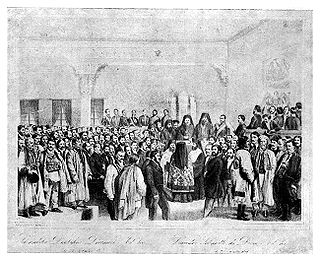
The two Ad hoc Divans were legislative and consultative assemblies of the Danubian Principalities, vassals of the Ottoman Empire. They were established by the Great Powers under the Treaty of Paris. By then, the Crimean War had taken the two states out of Russia's sphere of influence, and had nullified the Moldo-Wallachian Regulamentul Organic regime. Officially, the two assemblies were provisional replacements for the traditional assemblies, the Sfaturi. The term "divan", is derived from the Ottoman rule, being the name of a high governmental body in a number of Islamic states.

The territorial evolution of Romania includes all the changes in the country's borders from its formation to the present day. The precedents of Romania as an independent state can be traced back to the 14th century, when the principalities of Moldavia and Wallachia were founded. Wallachia during its history lost several portions of its territory, either to the Ottomans or the Habsburgs. However, this land would be later essentially recovered in its entirety. Moldavia, on the other hand, suffered great territorial losses. In 1774, the Habsburgs invaded Bukovina and annexed it one year later, and in 1812, the Russian Empire took control of Bessarabia. Both territories were later exposed to powerful colonization policies. The principalities declared unification in 1859 as the Principality of Romania. This new state sought independence from the Ottoman Empire's vassalage, and in 1878, it fought a war against it alongside Russia. However, the latter would annex Southern Bessarabia, which was recovered decades before. Romania received Northern Dobruja as compensation, and would wage a war for the southern part against Bulgaria in 1913.

The unification of Moldavia and Wallachia, also known as the unification of the Romanian Principalities or as the Little Union, happened on 1859 following the election of Alexandru Ioan Cuza as prince of both the Principality of Moldavia and the Principality of Wallachia. A potential unification between the two principalities, which shared a common Romanian ethnicity, language and culture, had been attempted to be avoided by the great powers for a long time, although it was allowed at the moment it happened. The unification of these two states began a political struggle in the new country to find out which of the two regions would obtain "supremacy" and met some opposition in Moldavia by the so-called "separatists".


























